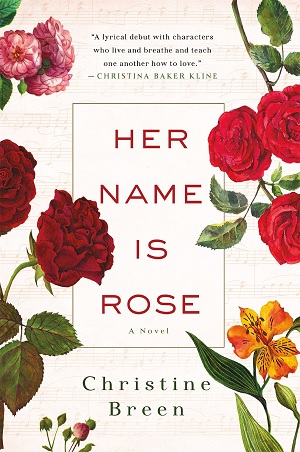
Her Name Is Rose
by Christine Breen
St. Martin’s Press, 2015
Reviewed by Barbara Free, M.A.
The book is well-written, with plenty of suspense and unexpected twists and turns, and a very unexpected ending, good enough that I won’t reveal too much of the plot, so as not to spoil it for the potential reader. Although the narration shifts between the adoptive mother, Iris, the daughter Rose, and a man named Rowan, whose role isn’t known at first, the real viewpoint is still always that of Iris. When one reads a book, particularly a novel, one forms a mental picture of the characters. In this case, I kept seeing Dame Judi Dench as Iris in my head, as she was about Iris’s age. Iris is much younger than Ms. Dench was when she portrayed Philomena Lee, the Irish birth mother in the film, Philomena. Ms. Breen’s picture is on the dust jacket of the book, and she doesn’t look a thing like Judi Dench. It may be that my mind was picturing Judi Dench portraying a woman named Iris in another film. So I had to clear out my mental image!
The premise of the story is that Iris and her husband adopted Rose when she was an infant—not a newborn—and met the birth mother once before “placement,” when she requested they keep the baby’s name, “Rose,” which happened to be the name they had already chosen. They had no further contact with the birth mother, and knew only her first name, Hilary. Iris, like the author, is a gardener and, besides the names Iris and Rose, there are frequent descriptions of flowers, some commonly known, some obscure; some apparently symbolic, some not. When the daughter is just grown, the husband dies of cancer. When he is terminal, he asks Iris to promise she will find Rose’s birth mother, so that if “anything should happen” to Iris, Rose will not be alone. Iris agrees, very reluctantly, and takes no action until she has a mammogram and is afraid she, too, could have cancer. She goes to the adoption agency and is told that they cannot give her the birth mother’s name, but could give it to Rose. However, the social worker, having heard Iris’s story, deliberately leaves the room for several minutes, leaving the file in plain sight so Iris can look in it, which she does. She finds a copy of the original birth certificate with the birth mother’s name, and an envelope with her address at the time of the adoption.
She takes the envelope and hides it. When the social worker returns, they look at each other knowingly, but neither acknowledges what each knows Iris has done. She leaves hurriedly. Telling no one, not her best friend nor even Rose, she gets on a plane in Shannon, Ireland, and flies to Boston to try to find Hilary Barrett.
The rest of the story is part wild goose chase, part discovery of herself and, to some degree, letting go of the need to control her daughter’s life. Rose is nineteen and studying violin in London. Iris seems to need assurance, always, that she is Rose’s “real” mother, which would indicate that she does not feel sure of that herself. It is a novel, and yet seems to closely mirror the author’s concerns expressed in her previous autobiographical books. The erroneous idea is that a person can have only one set of “real” parents, so the only way for adoptive parents to be real is to legally erase the birth parents and try to erase their existence.
A small irony, early in the book, is a sentence from Rose’s viewpoint: “Her mad, loveable mother would start singing, nearly as good as Joni Mitchell.” (Joni Mitchell, in real life, is a birth mother!)
For a reader with no adoption connections, this is no doubt a really enjoyable book. For those who have adoption connections, it is still a good book, but may have some painful or frustrating moments.
Excerpted from the February 2021 edition of the Operation Identity Newsletter
© 2021 Operation Identity